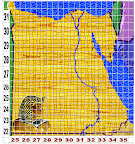Say the 4 pics above were 4 different glyphs which were adopted by the international association of transcribers. When viewed in the screen, the numbers would not be visible, but by assigning a 4 digit number to all glyphs, any hieroglyphic source ever typed into the data base would NEVER have to be typed in again.
No one would have to create the same glyphs again.
If you know about ASCII codes, each character has it's own number. That number will render the same ASCII character in any computer. The key to a standard set of hieroglyphic characters is assigning a code for each character.
===============================
Kind of like one of those online libraries... BUT regulated by an international organization of Egyptology standards.
The hieroglyphic source would be entered into their international data base.
The Standardized Encyclopedia of Hieroglyphics
Once entered researchers could locate the hieroglyphic source:
THE INSCRIPTION OF KAMOSE AT KARNAK..
A standardized description of the source
The transcribed characters (digital version) of the source
A link to a high resolution of the glyphs
The code for displaying a duck on JSesh or other hieroglyphic editors will NOT be the same line of code... the beauty of the 4 digit number assigned to each glyph. If the standardized code for a duck was 213, then that glyph would be displayed in any hieroglyphic editor that adopted that standardized system.
As the transcriber created a copy of a hieroglyphic source into a digital file, they would see the same glyphs on their screen as the source they were transcribing.. BUT in the back ground, the program would also generate the code for each glyph
0021 2215 0456 ... the ASCII file, for each glyph typed in, a 4 digit number would be typed into a file and be placed in the shared data base of hieroglyphics already entered.
Future researchers could look up a particular source and they could do a word search.
If there were 10 or 10,000 hieroglyphic sources entered into the data base, a word search could find every source and the researcher could look at how that word was used in the context of other sources.
===============================
The reason why the internet is what it is today is because of the development of the htm code which is freely used by millions. You don't have to pay to create a htm file.. you don't have to pay to display a htm file ... you can create a htm file, simply by typing in your word processor.
If a standard set of glyphs are assigned numbers and made public domain, and a free reader (like Internet Explorer) to read the codes is established, then hieroglyphic transcribing / reading will move up to the class of htm.
If any one can write a program, that lets you enter numbers to display a specific glyph, I will create an example of how it can be used to create a super search of all hieroglyphics ever entered into a data base.
===================
Before you start, tell me this ... no matter what hieroglyphic editor you use, can you copy THE INSCRIPTION OF KAMOSE into your editor, create a file and place your digital copy on a web page, so the public can see the glyphs you entered ?
~
zendz


No comments:
Post a Comment